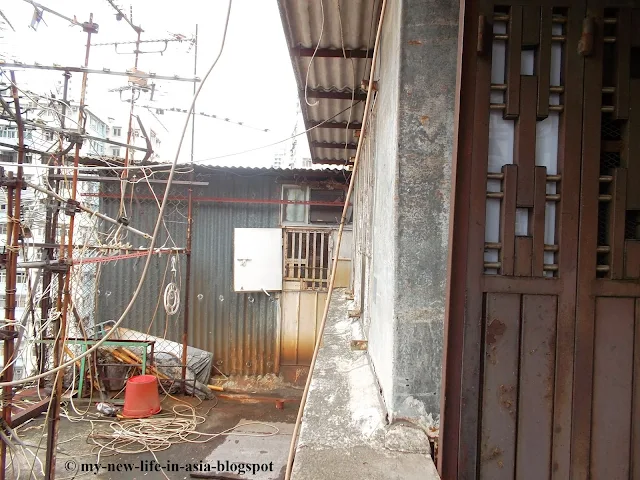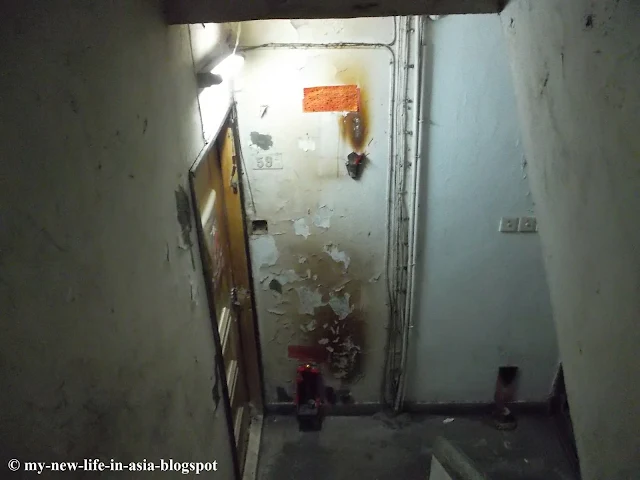Hong Kong's Rooftop Slums
 |
| An illegal rooftop house (left), and behind it an HSBC building |
It is perhaps no wonder that in Hong Kong- the most vertical city in the world, where land is a precious good, almost a luxury - slums don't grow in the outskirts, but on rooftops.
The old, decaying buildings from the 1950s and 60s scattered all over Hong Kong may look unappealing to foreign visitors, who are likely to prefer the glamorous central districts and the numerous tourist attractions. However, there is something unique about those apparently unremarkable structures. Their rooftops reveal one of the most bewildering facets of the city: the co-existence of wealth and poverty, of monumental skylines and third-world-like skyghettoes in this world metropolis.
The old, decaying buildings from the 1950s and 60s scattered all over Hong Kong may look unappealing to foreign visitors, who are likely to prefer the glamorous central districts and the numerous tourist attractions. However, there is something unique about those apparently unremarkable structures. Their rooftops reveal one of the most bewildering facets of the city: the co-existence of wealth and poverty, of monumental skylines and third-world-like skyghettoes in this world metropolis.
I am lucky enough to share a flat with a Hong Kong artist, who gives me a lot of insights into the life of her hometown. A few days ago she told me that she would visit some rooftops with a group of French photographers. She told me that many rooftops in Hong Kong are home to squatters who build there illegal homes. I wanted to see that, so I asked if I could join them.
We went to Prince Edward (see map below), an area where there are many buildings from the 1950s and 60s, constructed in the pre-skyscraper phase of Hong Kong's urban planning history.
Most of these buildings are 6-10 storeys high and have no lift. We looked for the buildings whose entrance door was opened, entered and climbed up the narrow, dirty stairs.
Most of these buildings are 6-10 storeys high and have no lift. We looked for the buildings whose entrance door was opened, entered and climbed up the narrow, dirty stairs.
 |
| Entrance of one of the buildings |
 |
| Buildings from the 1950s and 60s. They are smaller than the ones constructed in the following decades and have no lifts |
 |
| One of the houses illegally built on a rooftop |
 |
| You can see that it's made of very poor materials. Water and electricity are probably tapped from the building illegally |
 |
| The main door of the hut |
 |
| View from the rooftop |
 |
| Another sign that someone's living on the rooftop |
Later we went to another rooftop in Mong Kok area. It was even more impressive than the previous one. Squatters' huts were all around. As you can see below, the huts are built right in front of an HSBC skyscraper: a symbol of Hong Kong's wealth facing a symbol of its poverty.
 |
| The huts on the rooftop are all illegal settlements |
 |
| You can clearly see illegal houses from the distance |
 |
| Another illegal house |
 |
| Illegal huts are only on the rooftops of older buildings, not on those of more modern, taller public houses like the ones you see on the horizon |
 |
| Doors inside the building |
Illegal Housing in Hong Kong
Illegal Housing is a very old phenomenon in Hong Kong. In one of my previous posts I described the Kowloon Walled City which, with a population of around 40,000, was probably the biggest squatter settlement in any developed country. The issue of illegal housing is perhaps one of the major constants in the post-war history of the city. The British colonial government tried to address it by starting one of the biggest public housing and resettlement projects in the world, matched perhaps only by Singapore. It is not a coincidence that massive public housing has given many areas of Hong Kong the looks of a giant socialist city. By 1969 the government had already resettled more than 1.5 million people, out of a total population of about 4 million (Tsang 2011 , p. 199).
, p. 199).
The conspicuous phenomenon of illegal housing in Hong Kong has two main reasons: scarcity of land and the traditionally wide wealth gap.
Hong Kong’s population expanded from about 600,000 in 1945 to over 2 million in 1950, and to 2.5 million in 1955 (ibid., p. 167). The influx of people let the population swell continuously. As you can see from the chart below, the population has never stopped growing and had reached more than 7 million by 2011.
| Year | 2001 | 2006 | 2011 |
|---|---|---|---|
| Population | |||
| Total | 6 708 389 | 6 864 346 | 7 071 576 |
When Hong Kong was still a developing country, the problem of squatting was endemic. A study from the 1970s explains:
Hong Kong, like other cities of the developing world, has in the last few decades experienced many urban problems arising from a very fast rate of population growth ... The inability of house construction to cope with the swollen population has resulted in large numbers of squatters ... The Hong Kong government has in the last fifteen years launched a large scale resettlement programme for squatters ... Nonetheless, the squatter problem has by no means been solved. There are still 380,000 squatters in about 113 squatter areas ... The general impression of squatter areas is one of disorderly arranged agglomerations of flimsy structures occupied by poverty-stricken people at high densities, with little or none sanitary facilities and other amenities like piped water and electricity supply ... (Wong 1971, p. 89).
However, because of the swelling population and the lack of space many Hong Kongers have grown accustomed to using every available centimeter whenever possible. Up to the 1980s "[r]ooftop squatters, illegal extensions from balconies, enclosures of airwells ... bags of belongings hanging out of windows, illegal street vending, religious shrines, washing vegetables or assembling plastic flowers in the street, illegally adding residents to public housing units" were common (Smart 2006 , p. 51). Though the situation has improved in recent decades, these phenomena have by no means disappeared.
, p. 51). Though the situation has improved in recent decades, these phenomena have by no means disappeared.
Wealth Gap and Hunger For Land
Despite being an overall rich city, Hong Kong has one of the highest Gini coefficients in the world (.533 in 2006), and "the widest income gap between the rich and the poor in Asia" (Chiu/Wong 2011, p. 1).
According to Li Kui-wai, professor of economics at the City University of Hong Kong, after the financial crisis of 1997, the Hong Kong economy "became more rigid. More than 90 percent of our economy is now services, where income grows slower. Now we don’t see upward mobility” (note).
Between 2001 and 2010, incomes for Hong Kong’s top 10 percent grew by 60 percent, while the bottom 10 percent saw their incomes drop by a fifth (note). As a recent study states:
The social landscape in the 1970s and 1980s was one of rapid economic growth that generated ample opportunities for mobility for people of diverse backgrounds, thus reinforcing the belief that Hong Kong was a "land of opportunity" for anyone willing to work hard for personal success. Nowadays, the effects of economic recovery are uneven, benefiting those in growing business sectors (such as business services and finance) and leaving many behind (Chiu/ Wong 2011, p. 77).
Adding to the social problems and inbalances, Hong Kong's property markets is the world's most expensive. Housing prices have seen a 85% rise since 2009, and a one-bedroom flat at The Belcher's costs over $1.5 million (note). Even homes in less fashionable areas cost around 13 times the annual average household income. Between 2009 and 2013 residential property prices increased 120% and commercial property prices rose 90% (note).
Against this backdrop, it is not surprising that people who are on the waiting list for a public house or who cannot afford one, resort to squatting by building a small home on a rooftop. As to 2006 there were "3,962 rooftop dwellers in 1,556 households in Hong Kong" (note). These illegal settlements are tolerated by the authorities, often because the government has not the means or any short-term plan for the relocation of the squatters and prefers to close an eye instead of throwing them on the streets. Apparently, it is preferable to accept illegality than risk to create social unrest.
The city skyline thus becomes a symbol of Hong Kong's disparities and of the two extremes of laissez-faire capitalism. On the one hand the monumental skyscrapers, the most majestic emblems of capitalism and of the "mirage of collective will" (Huang 2004 , p. 18) to be successful, fashionable and rich; on the other, the slums where members of the lower classes take refuge. Though spatially separated from each other, many skyslums have sprouted right in front of skyscrapers. The lack of space has brought about a striking symbiosis between rich and poor, and a co-existence in mutual indifference.
, p. 18) to be successful, fashionable and rich; on the other, the slums where members of the lower classes take refuge. Though spatially separated from each other, many skyslums have sprouted right in front of skyscrapers. The lack of space has brought about a striking symbiosis between rich and poor, and a co-existence in mutual indifference.










Comments
Post a Comment